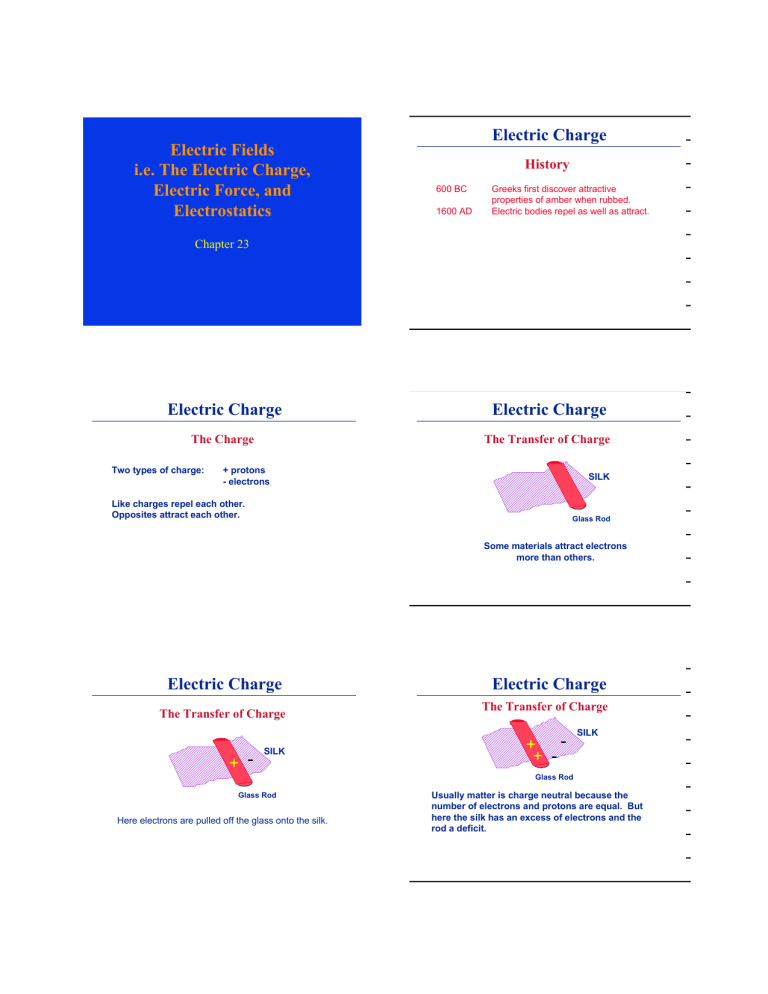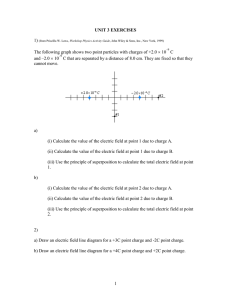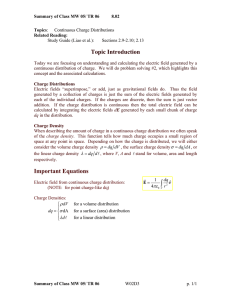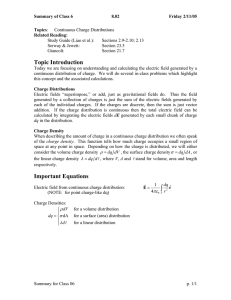Electric Fields i.e. The Electric Charge, Electric Force, and
advertisement

Electric Fields i.e. The Electric Charge, Electric Force, and Electrostatics Electric Charge History 600 BC 1600 AD Greeks first discover attractive properties of amber when rubbed. Electric bodies repel as well as attract. Chapter 23 Electric Charge Electric Charge The Charge The Transfer of Charge Two types of charge: + protons - electrons SILK Like charges repel each other. Opposites attract each other. Glass Rod Some materials attract electrons more than others. Electric Charge The Transfer of Charge + - SILK Electric Charge The Transfer of Charge + + - SILK Glass Rod Glass Rod Here electrons are pulled off the glass onto the silk. Usually matter is charge neutral because the number of electrons and protons are equal. But here the silk has an excess of electrons and the rod a deficit. Electric Charge Electric Charge The Transfer of Charge The Transfer of Charge + - + + - ++ ++ - - - + SILK Glass Rod SILK Glass Rod Glass and silk are insulators: charges stuck on them stay put. Electric Charge Electric Charge History Conductors Vs. Insulators In conductors, charges are free to move about. The charges (usually electrons) arrange themselves into a static situation (Ftot = 0). Conductors with a net charge (positive or negative) have the excess charge move to the surface, if no other forces are present. Metals are conductors! In insulators, charges cannot move freely. The charges stay where they are put. Electric Charge Summary of things we know: – There is a property of matter called electric charge. (In the SI system its units are Coulombs.) – Charges can be negative (like electrons) or positive (like protons). – In matter, the positive charges are stuck in place in the nuclei. Matter is negatively charged when extra electrons are added, and positively charged when electrons are removed. – Like charges repel, unlike charges attract. – Charges travel in conductors, not in insulators – Force of attraction or repulsion ~ 1 / r2 600 BC Greeks first discover attractive properties of amber when rubbed. Electric bodies repel as well as attract 1600 AD 1735 AD 1750 AD 1770 AD 1890 AD du Fay: Two distinct types of electricity Franklin: Positive and Negative Charge Coulomb: “Inverse Square Law” J.J. Thompson: Quantization of electric charge - “Electron” and ... Charge is Quantized q = multiple of an elementary charge e: e = 1.6 x 10-19 Coulombs electron proton neutron positron Charge -e +e 0 +e Mass 1 1836 1839 1 Diameter 0 ~10-15m ~10-15m 0 (Protons and neutrons are made up of quarks, whose charge is quantized in multiples of ± ne/3. Quarks can’t be isolated under normal conditions.) ! F12 Gravitational and Electric Forces of the Hydrogen atom Coulomb’s Law r12 q1 q2 M +e r"12 ! kq q F12 = 1 2 2 r"12 r12 Force on 1 due to 2 r12 -e m Gravitational force m = 9.1 10-31 kg M = 1.7 10-27 kg r12 = 5.3 10-11 m Electric Force πε0)-1 = 9.0 x 109 Nm2/C2 k = (4πε ε0 = permitivity of free space = 8.86 x 10-12 C2/Nm2 Gravitational and Electric Forces of the Hydrogen atom 10-31 kg M +e r12 q m Gravitational force m = 9.1 M = 1.7 10-27 kg r12 = 5.3 10-11 m Q = -q = 1.6 10-19C Electric Force ! Mm Fg = G 2 r" r12 ! 1 Qq 2 rˆ Fe = 4πε 0 r12 Fg = 3.6 10-47 N Superposition of forces from two charges Blue charges fixed , negative, equal charge (-q) What is force on positive red charge +q ? y --qq -q -q +q x +q Fe = 8.2 10-8N Superposition of forces from two charges Blue charges fixed , negative, equal charge (-q) What is force on positive red charge +q ? Consider effect of each charge separately: Superposition of forces from two charges Blue charges fixed , negative, equal charge (-q) What is force on positive red charge +q ? Take each charge in turn: y y --qq --qq +q +q -q -q -q -q x +q +q x Superposition of forces from two charges Superposition of forces from two charges Blue charges fixed , negative, equal charge (-q) Blue charges fixed , negative, equal charge (-q) What is force on positive red charge +q ? What is force on positive red charge +q ? Find resultant: Create vector sum: y y --qq NET FORCE --qq -q -q -q -q x +q +q x +q +q Superposition Principle ! F13 q1 q2 F13 y ! F12 F13 x F12 y q3 → Example: electricity balancing gravity ! F13 ! F ∧ ! F12 ∧ • What forces are acting on the charged balls ? • Write the forces in Cartesian coordinates. • Equate forces (Newton’s 3rd law) • Solve for unknowns! Example: electricity balancing gravity ! FE ! T ! ! FG = mg q m m F12 x F = ( F12 x + F13 x ) i + ( F12 y + F13 y ) j • Draw vector force diagram while identifying the forces. • Apply Newton’s 3rd Law for a system in equilibrium to the components of the forces. • Solve! q ! T Example: electricity balancing gravity If θ = 20o, m = 3 mg, and L = 0.75 m, what is q and the forces are acting on the charged balls? ! FE ! ! FG = mg ! FE ! q1 q2 FE = k 2 1 ! FE = k 2Li θ 2 2 2 q i 2 L L ! T θ q q m ! ! FG = mg m Example: electricity balancing gravity Example: electricity balancing gravity ! FG = mg = (3 ×10 −6 kg ) 9.8 sm2 = 2.94 × 10 −6 N ( ! ! FG also, T = ) ! FE = k mg = cosθ cosθ L L 2.94 × 10 −6 N = = 3.13 × 10 −6 N cos(20o ) ! FE ! T q= θ q q2 4L sin 2 θ 2 (1.07 ×10 −6 ! FE 4 L2 sin 2 θ q= k N )4(0.75m ) sin ( 20o ) 2 9 × 109 Nm C 2 2 m ! ! FE = T sin θ = 3.13 × 10 −6 N sin(20 o ) = 1.07 ×10 −6 N ! T ! FE q q ≅ 7.19 × 10 −9 C L L 2 q m m ! ! FG = mg θ q ! ! FG = mg example problem example problem Example: Three point charges are arranged as shown in the figure. Find the total force on 3 due to 1 and 2. Example: Three point charges are arranged as shown in the figure. Find the total force on 3 due to 1 and 2. q1 = -1 x 10-8 C, q2 = 5 x 10-8 C, q3 = 2 x 10-8 C, Assume: m position (0, 0.5 m) position (0.8 m, 0) position (0, 0) q1 = -1 x 10-8 C, q2 = 5 x 10-8 C, q3 = 2 x 10-8 C, Assume: position (0, 0.5 m) position (0.8 m, 0) position (0, 0) ! kq 3 q 1 (9 × 10 9 )(2 × 10 −8 )(− 1 × 10 −8 ) N − ˆj ≅ 7 .2 × 10 −6 N ˆj rˆ 31 = F 31 = 2 r31 (0 . 5 )2 ( ) ! kq 3 q 2 (9 × 10 9 )(2 × 10 −8 )(5 × 10 −8 ) N − ˆi ≅ −1.4 × 10 −5 N ˆi rˆ 32 = F 32 = 2 y r32 (0 .8 )2 ! ! ! F = F31 + F32 = 7 .2 × 10 − 6 ˆj - 1.4 × 10 − 5 î N q1 = - 1.4 î + 0 . 72 ˆj × 10 − 5 N ( ) y ( ( q1 ) ) F31 q3 x q2 F32 Example: Two Charged Spheres a L What is the charge on each sphere? θ Mass of each sphere is 30 g. L=15 cm. θ = 50 . Mass of each sphere is 30 g. L=15 cm. θ = 50 . L The total force on each sphere is zero: From geometry we see that a = L sin θ = (0.15 m) sin 50 = 0.013 m Therefore the separation of the spheres is 2a = 0.026 m x q2 Example: Two Charged Spheres What is the charge on each sphere? θ q3 Fy = 0 = T cos θ - mg so T =mg/cosθ Fx = 0 = T sin θ - Fe so Fe= Tsinθ = mg tanθ a Left-hand sphere: Fe θ T mg But also Fe = kq2/r2 (Coulomb’s law), Equating Fe= Fe gives kq2/r2 = mg tanθ gives q2 =(1/k) r2 mg tan θ q = 4.4 10-8 C Example: Point Charge The Electric Field ! • A set of fixed charges exerts a force F given by ! Coulomb’s law on a test charge qtest at position .r qtest ! r ! F ! r Q ! • The electric field is represented by the symbol E , and is given in terms of this force by: !# !# !# F E( r) = qtest • Find the electric field of a point charge Q located at the origin. This is a vector function of position. !# 1 Qqtest ˆr F= 2 r 4 πε 0 ## • Dividing out qtest gives the electric field at !# !# 1 Q ˆ E( r) = 2 r 4πε 0 r # ! r: Radially outward, falling off as 1/r2 The Electric Field Example: Point Charge !# !# E( r) = qtest 1 Q ˆr 4πε 0 r 2 • The concept of electric fields was invented by Michael Faraday to describe his model of how charges interact. • Charges interact by exerting forces on each other. Faraday thought of the fields as “lines of force” (sort of like strings) with a density in space proportional to the strength of the force. ! ! E + Vector ! Field (Show E at each ! r) - Field Lines (Lines of force) Positive charge (Source) Force due to an electric field ! Just !turn ! the definition of E around. E r If ( ) is known, !the force on a charge q at point r is: !# !# !# F = q E (r ) ## E Negative charge (Sink) Electric fields due to various charge distributions q + The electric field is a vector which obeys the superposition principle. ! The electric field at r points in the direction that a positive charge ! placed at r would be pushed. Electric field lines are bunched closer where the field is stronger! Begin with a simple example with discrete charges: the dipole Field Due to an Electric Dipole Electric fields from continuous distributions at a point x straight out from its midpoint Find +q r ! ! ! E ( x ) = E+ + E− Electric dipole moment p = qd θ Up to now we have only considered the electric field of point charges. Now let’s look at continuous distributions of charge --- lines or surfaces or volumes of charge --- and determine the resulting electric fields. d x -q ! E− ! E+ ! E Sphere Electric fields from continuous distributions For discrete point charges, we can use the superposition principle and sum the fields due to each point charge: !! ! E(r) = ∑ Ei q2 q3 q1 q4 i Ring Sheet Electric fields from continuous distributions For discrete point charges, we can use the superposition principle and sum the fields due to each point charge: !! ! E(r) = ∑ Ei q2 q3 q1 i q4 What if we now have a continuous charge distribution? q Electric fields from continuous distributions E(r) Electric fields from continuous distributions - We divide the distribution up into small pieces, then we sum the contribution to the field from each piece: Vol. ! ! ∆q ∆Ei ( r ) = k 2 i rˆ r ! ! ! ! ∆q E (r ) ≈ ∑ ∆Ei (r ) = ∑ k 2 i rˆ r i i ∆qi In the limit of very small pieces, the sum is an integral Vol. ! ! E ( r ) = lim ∆ qi → 0 ! ! E (r ) = →dq ∆q→ Hence, ∑k i , vol ∫ Vol . k ∆ qi rˆ r2 dq rˆ r2 ! ! ! ! dq ∧ E(r ) = ∫ dE, dE = k 2 r r Electric fields from continuous distributions y P !! ! Hence, E(r) = ∫dE ! ! E (r ) = dq dq ∫kr 2 What is field at P? −∞ ! ! dq dE ( r ) = k 2 r" r Vol. Example: An infinite thin line of charge. +∞ Charge per unit length is λ rˆ Vol . Example: An infinite thin line of charge. Example: An infinite thin line of charge. ! dE+ y What is field at P? P P r= y −∞ +∞ dq x Charge per unit length is λ Consider small element of charge, dq, at position x. ! dE dq −∞ ! dq dE + = k 2 r" r • Consider small element of charge, dq, at position x. • dq is distance r from P. • dq produces dE at P. ! dE ! dq dE + = k 2 r" r dE y = 2k θ dq cosθ r2 λ dx, cosθ θ=y/r dq=λ dq -x ! " E = yE ! dE− ! dE+ θ dq −∞ +∞ x ! " E = yE ! dE− ! dE+ x2 + y2 +∞ x dq −∞ • Consider small element of charge, dq, at position x. ! dq dE + = k 2 r" r • dq is distance r from P. • dq produces dE at P. dE y = 2k • For each dq at +x, there is a dq at -x. dq cosθ r2 λ dx, cosθ θ=y/r dq=λ dq -x +∞ x dE y = 2kλ dx y ⋅ (x2 + y 2 ) r x=∞ Ey = ∫ (x 2 x=0 2kλy 2kλ 2 3/2 dx = +y ) y Example of continuous distribution: ring of charge Example of continuous distribution: ring of charge Find the electric field at a point along the axis. Hint: be sure to use the symmetry of the problem! Find the electric field at a point along the axis. Hint: be sure to use the symmetry of the problem! ! dE ! dE ! r z Thin ring with total charge q: charge per length is λ = Thin ring with total charge q: charge per length is dq R q 2π R λ = Chap 23: Example A uniform electric field exists in a region between two oppositely charged plates. An electron is released from rest at the surface of the negatively charged plate and strikes the surface of the opposite plate, 2.0 cm away, in a time 1.5 x 10-6 sec. (a) What is the speed of the electron as it strikes the second plate? (b) What is the magnitude of the electric field E? 1 x = x0 + v0 t + at 2 2 + + + + + + + + 1 2 2 cm = 0 + 0 + a (1 .5 × 10 − 6 s ) 2 ea = 1 .78 × 10 12 cms -2 - 2 - - - - - - (a) v − v 0 = 2a(x − x 0 ) v 2 = 2a(x) → v = 2a(x) v = 2.6 × 10 6 cm s ! r z 2 ma q 9.11× 10-31 kg(1.78 ×1010 sm ) E= ≅ 0.1 NC 1.6 ×10-19 C (b) F = ma = qE, E = 2 q 2π R dq R Break the charge up into little bits and find the field due to each bit at the observation point. Then integrate. This is an important example problem in the Text!




